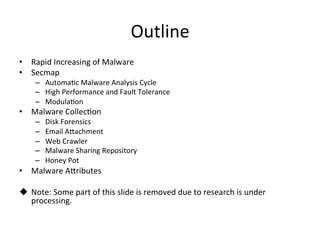Malware collection and analysis
- 1. Malware Collec+on and Analysis C.K.Chen @ DSNSLab, NCTU 2014/05/20
- 2. DSNS • Boss – 謝續平教授 • IEEE Fellow • ACM Dis+nguished Scien+st • 國立交通大學資訊工程系特聘教授 • 資通安全研究與教學中心主任 • 法務部調查局顧問 • 實驗室研究方向 – 惡意程式分析 – 虛擬機器 – 數位鑑識 – 網路安全
- 3. Outline • Rapid Increasing of Malware • Secmap – Automa+c Malware Analysis Cycle – High Performance and Fault Tolerance – Modula+on • Malware Collec+on – Disk Forensics – Email ASachment – Web Crawler – Malware Sharing Repository – Honey Pot • Malware ASributes u Note: Some part of this slide is removed due to research is under processing.
- 4. Rapid Increasing of Malware • Malware increasing McAfee Labs Threat Report in Fourth Quarter 2013
- 5. Malware Life Cycle • Malware Life Cycle and Response Window hSp://www.fireeye.com/blog/corporate/2014/05/ghost-‐hun+ng-‐with-‐ an+-‐virus.html
- 6. Malware Analysis Ecosystem Internet • Machine Learning • System Level Virtual Machine • Taint • Symbolic • Complex Analysis • Signature-‐based Detec+on • Classifier • Informa+on Collec+on & Feedback Back-‐end Cloud Front-‐end Device 4. Feedback Info 3. Update Signature/Model 1. Gathering Sample 2. Analysis
- 7. SECMAP • Scalable sEcurity Cloud-‐compu+ng for Malware Analysis Pla_orm(SECMAP) – Aim to automa+c whole analysis procedure • Malware Collec+on • Malware Storage • Malware Analysis • Large Scale Data Mining – Increase throughput with high performance compu+ng – Decrease overall process +me to shorten response window
- 9. Analyzers • Malware Behavior Analyzer • Forensor • Malware Func+on Call Trcer • Malware Code Block Retriver • Instruc+on Trace • Rootkit Detec+on • …….. • ClamAV • Avira • Trend Micro • Kaspaskey • VirusTotal
- 11. Malware Collec+on • Malware samples can help to construct detec+on model, design signature • Therefore, we use following way to collect samples – HoneyPot – Web Crawler – Shared Repository – Email – Disk Forensics – User Upload
- 12. Disk Forensics • When host are infected, disk forensics is needed to discover malware – Delete – Hidden • Dele+ng file is one of important behavior of malware – About half of malware delete some files when execu+on – Malware oden delete log files , binary created or remove itself to prevent from forensic • It is useful if we can recover files deleted by malware
- 14. Recover Mechanism • In sodware approach – Basic method need file system’s meta-‐data to recover files – File carving is proposed to recover files without file system’s meta-‐data
- 15. File System Data Structure Filename Start cluster Recover.jpg Cluster 50 Hello.txt Cluster 53 Cluster number Next cluster 50 51 51 52 52 EOF 53 57 Recover.jpg content Recover.jpg content Recover.jpg content Hello.txt content Unknown Cluster 50 Cluster 51 Cluster 52 Cluster 53 Cluster 54 Directory Entry File Alloca+on Table Disk Data Area 15/14
- 16. Delete a File Filename Start cluster _ecover.jpg Cluster 50 Hello.txt Cluster 53 Cluster number Next cluster 50 0 51 0 52 0 53 57 Recover.jpg content Recover.jpg content Recover.jpg content Hello.txt content Unknown Cluster 50 Cluster 51 Cluster 52 Cluster 53 Cluster 54 Directory Entry File Alloca+on Table Storage Data Area 16/14
- 17. Basic Recover Method Filename Start cluster _ecover.jpg Cluster 50 Hello.txt Cluster 53 Recover.jpg content Recover.jpg content Recover.jpg content Hello.txt content Unknown Cluster 50 Cluster 51 Cluster 52 Cluster 53 Cluster 54 Directory Entry File Alloca+on Table Disk Data Area Cluster number Next cluster 50 0 51 0 52 0 53 57 Predict file allocate in con+nues cluster 17/14
- 18. File Carving Method Recover.jpg content Recover.jpg content Recover.jpg content Hello.txt content Unknown Cluster 50 Cluster 51 Cluster 52 Cluster 53 Cluster 54 Storage Data Area FF D8 AA BB 01 33.... ... 70 BB 01 2A FF D9 JPEG files use “FF D8” as header and “FF D9” as footer 18/14
- 19. Recover Result
- 20. Web Crawler • To collect malware across the web, we use crawler to automa+c download files from internet – Nutch + Hadoop – Collect about 10000 files 1 /day • Rarely malicious – Not run javascript – No vulnerability – Password
- 21. Malware Sharing Repository • There are many website provide free malware sharing – ASack Response • Malc0de • Malware Black List • Malware Domain List – Malware Sharing • VXHeaven • Malware Dump • VirusSign • …….
- 22. Malware Profile File Metadata File Name “setup.exe” Origin File Name MD5(SHA1) Hash ccffcb94e4058ed22a94881ba2 d26f35 File Size 65024 File Type PE32 executable for MS Windows (GUI) Intel 80386 32-‐ bit IsMalicious True Some of our source may upload benign file File Source Collec+on Date 2013-‐11-‐21 Collec+on Source Email Email/Disk/Crawler/Honeypot Collec+on Loca+on bletchley@dsns.cs.nctu.edu.t w Email address, disk id, URL, ip of honeypot
- 23. Executable Related ASribute Behavior Network Trace Log All Communica+on Flow Instruc+on Trace Log All Instruc+on Executed Func+on Trace Log All API func+on code Modified Files All Modified Files Shellcode Shellcode iden+fied in Files (document only) Modified Registry All Registry Modified SSDT Hook If SSDT changed by this sample MBR Modified If this sample modified MBR Screenshots
- 24. Security Detector ASributed An:Virus Packer Packer Name PEID AV Result All an+virus report ClamAV, Kaspersky, Norton…. Other Field Needed by Each Analyzer
- 25. Conclusion • Secmap is an infrastructure to automa+c collect, analysis and store the malware sample • Different Way to collect wide range of samples – Honeypot – Disk – Email – Web
- 26. Q&A


























